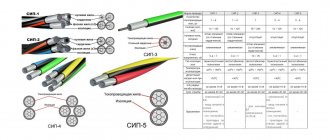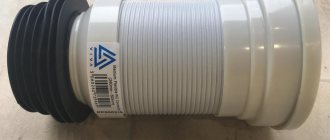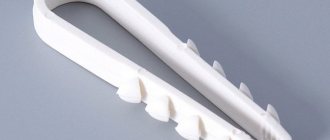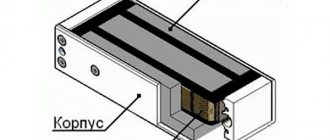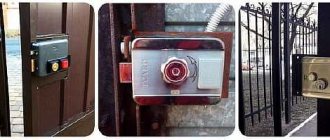Advantages of fastening with a dowel clamp
- Installation is simple and does not take much time
- Ability to quickly replace failed fasteners
- The dowel-clamp is resistant to ultraviolet radiation
- Can hold quite a lot of weight
- Can be used both indoors and outdoors. Since it is possible to work with it at different temperatures
Disadvantages of using dowels
- Appearance, it is not very aesthetic, so they try not to fix it in a visible place
- When working with such a mount at high temperatures, it can be subjected to deformation
Why is the wiring fixed?
Fastening electrical wiring is necessary in all cases, regardless of the method of its installation. Hidden laying requires reliable fixation of the wire inside the groove so that the cable does not extend beyond its edges and does not interfere with plastering and finishing work.
When using the open method, the conductors also need to be secured along the entire laying line, and only then covered with boxes and other decorative elements. The same applies to installation under suspended or suspended ceilings. In this case, grooves are not required, and the wires are fixed along the route and hidden under the finish.
Cable lines are fastened in walls made of various materials - brick, concrete, wood, gypsum boards. Therefore, for work you will definitely need a drill or hammer drill, and it is best to use dowel clamps as clamps.
Design
A dowel-clamp is a fastener that can be used to attach wires or pipes, both hard and soft, to brick, aerated concrete, foam concrete. The dowel is made in the form of a loop with an oval or round end.
- At the ends of this loop there are teeth, which cling to the material when fixed.
- Dowel - clamp has such functions as holding a wire or other attached material (clamp) and fastening directly to the surface (dowel).
- These clamps are often produced in two colors, black and white, but if desired and necessary, you can find other colors. There are several types of dowels. Basic.
"Helicopter"
Fastening in the form of a loop with a spacer. This type can withstand loads of up to 8 kilograms. With this fastening, you can fix not only cables, but also pipes with different coatings and shapes, the diameter of which should not exceed 32 mm.
Please note that when installing with these dowels, you must first put it on a pipe or cable, and only then fix it in the wall.
Bracket
A plastic strip with teeth, designed for fixing cables and pipes with a diameter of 6 to 25 mm. When calculating the number of fasteners, it is necessary to take into account the weight of the cable.
Arc Clamp
The shape of such a dowel is not in the form of a loop, but in the shape of an arc. And the diameter of the attached cable or pipe must match the size of the clamp. They are produced with one or two arcs, which allows the cables to be fastened in parallel.
Criterias of choice
The first thing you should pay attention to is the thickness of the cable being held. The size of the clamp has certain restrictions on the diameter of the cable being held, for example, 11-18 mm. On the packaging, manufacturing companies indicate the working cable diameters for a particular fastener.
It is also worth considering the following nuances when choosing fasteners:
Since manufacturers produce both flat and round cables, dowel clamps also come in similar shapes.
Release date - nylon loses its elastic properties and stretches after one and a half to two years from the date of manufacture. Therefore, it makes sense to purchase fasteners manufactured no earlier than a year before its installation.
The price of fasteners - nylon in its pure form as a material costs a penny, products made from it are also cheap, but short-lived. Adding halogens to nylon significantly extends its service life, but products made from this hybrid material are more expensive.
It is impossible to say for sure what is more profitable – cheap fasteners or expensive ones. It all depends on how long the fastener has served in this case without the need for replacement.
Installation platform with clamp
Thanks to this fastening, you can easily fix cables and pipes in a bundle and of different sizes. In appearance, this is an ordinary plastic dowel - a clamp with a tie and teeth, at the end of which there is a rectangular loop. By threading the clamp through the loop, the cable or pipe is secured.
The following materials are used in clamp dowels:
- Nylon is the most common material for making dowels. When comparing polyamide and polyester materials, the balance favors the former. They show the best mechanical performance. It is worth considering that the temperature of use of Nylon dowels is limited to +85 degrees.
- Polyethylene is considered the cheapest fastener. Its main and main disadvantage is intolerance to ultraviolet rays. Over time, the dowel becomes brittle and may fall apart, unable to withstand the load on it. An exception is the dowel made of stabilized polyethylene. This material is resistant to sunlight.
- Polypropylene - differs from the previous ones in hardness and strength, but also remains sensitive to ultraviolet radiation. Since dowels are often used inside buildings, you can turn a blind eye to intolerance to direct sunlight.
Types of products
Dowel clamps do not have a wide variety of categories and types, since they are highly specialized products. However, there are options for design features and materials of manufacture. For example, metal and plastic.
By design features
This criterion allows us to distinguish three main types of fastening:
- The staples are ordinary plastic strips with teeth to prevent backlash. Suitable for fastening wiring with a total diameter of 6-25 mm. The number of components depends on the weight of the cable. The technology can be used to fasten corrugated and smooth pipes of similar diameter.
- Mounting platform with clamp. When examining this product, you will find a plastic dowel with standard teeth, the end of which is equipped with a rectangular loop. The clamp must be threaded through the loop and the cable secured. The advantage of this method is the ability to tighten corrugations or bundles of wires of different diameters.
- Spacers or “helicopters”. The design involves the use of a dowel with a loop, inside of which you need to insert a plastic rod for a spacer. The maximum permissible load is 8 kg. You can attach cables, bundles of wires, corrugation with a diameter of up to 32 mm. Expansion dowel clamps are divided into two separate types. In the first case, the product is solid, the rod is installed in a dowel and driven into the wall along with it. The rigidity of the structure increases, but you must be careful when working with it, since first the cable or corrugation is threaded through the clamp, and only then the dowel is driven into the wall.
- The second type of spacer dowel clamps is an arched fastener without a loop. In this case, you can install a corrugation, wire or bundle of cables of a fixed diameter. That is, there is no suitable range, and the diameter of the cable must match the diameter of the arc. There are spacers with one or two arcs for parallel fastening of two corrugated pipes or wires.
According to screed materials
We are talking about the choice of material for making cable fasteners. Ties (clamps) can be made from nylon, polyethylene or polypropylene. Let's look at each of them separately:
- The most popular material is nylon. This is due to the increased strength and maximum load of polyamide components compared to polyester (which include the other two types of plastic). The material can be used at temperatures up to +85 degrees. Celsius. Higher temperatures lead to a reduction in the tensile strength of the nylon tie by 5-10 times. An excellent option for cables and wire bundles, but not suitable for fixing heating pipes.
- Polyethylene clamps are cheaper products with increased sensitivity to ultraviolet radiation, so they cannot be used outdoors. You can use dowel clamps made of stabilized polyethylene, but even in this case, over time, fragility increases and the load-bearing capacity of the products decreases.
- Polypropylene ties are durable and rigid products compared to polyethylene, but also sensitive to light. By adding a stabilizer, you can increase UV resistance, but this will increase the cost of the components. Since installation is often carried out inside buildings, sensitivity to ultraviolet radiation is not such a noticeable disadvantage.
Metal fasteners
A metal dowel - clamp is a stronger fastener. Outwardly, it looks like an ordinary dowel.
But, nevertheless, there are a couple of options for this fastener:
- Bug. The metal fastener is a self-tapping screw with a press washer. This dowel-clamp can withstand a load of no more than 10 kilograms. This type of fastener is used to secure cables and metal pipes, the diameter of which should not be more than 38 mm. Attention! When installing the cable, it is necessary to ensure its insulation. And in the place where the fastening itself is located, it is necessary to wrap it with thermal tape.
- Fastener with tape for clamp. The dowel itself is a long clamp and has a plastic tape. It can be made of either soft or hard material. The maximum length of this tape is 14 cm.
- Fastening with wire tape. This fastener is capable of securing a load of no more than 1.5 kg. It is made of heat-resistant steel with a special polymer coating. These clamps are available with a buckle, for more precise fastening, or without. In this case, the edges of the wire just need to be twisted.
It must be taken into account that the dowel is only a part of the fastener that provides support for the self-tapping screw or screw. More often, buyers accept a complete set under the dowel - this is a self-tapping screw, a clamp and a dowel.
Methods of attachment to different surfaces
Walls and ceilings are made from various materials with different structures and densities. Depending on this characteristic, the method of fastening changes:
- Dense - wood in any form, plaster and soft plaster solutions (including gypsum). A nail or self-tapping screw fits perfectly into all these materials. In some - OSB and some others - it is better to first drill a hole with a slightly smaller diameter than a self-tapping screw, and then screw it in. Nails are often driven in immediately without pre-drilling. Self-tapping screws are screwed into wood and products made from it. Only for attaching the cable it is better to take them with a flat head
- Solid. This category of materials includes brick, concrete, screeds, and cements. You can’t screw a self-tapping screw into them even with a pre-drilled hole. For such materials, dowel-nails are used (they are also called dowels). This is a fastener consisting of two parts - a plastic dowel cap and a metal (sometimes plastic) screw. In such cases, a hole is drilled in the material with a drill diameter equal to or slightly smaller than the diameter of the dowel. A plastic cap is inserted into the hole. Its top edge should be flush with the surface (if necessary, you can hit it a couple of times with a hammer to level it or cut off the excess with a sharp knife). Then a fastening element (plate, clamp, etc.) is applied, which is attached to the inserted dowel with a screw. Dowel installation
- Thin or soft. These are plastic, plasterboard, fiberboard, aerated concrete, foam concrete, etc. The usual fasteners do not hold in them; you need a special one, which has an extended “back” part. It has a large support area, due to which the fasteners can be held. Some examples of such fasteners (umbrella, butterfly dowel and dowel with drill) are presented in the photo. To attach the cable to thin walls, you need special fasteners.
Actually, these are all the surfaces that are encountered inside the house when laying wiring. But sometimes the cable also needs to be attached to a pole, for example, when the electricity supply from the pole to the house stretches, or to a pipe - when the cable rises along a flammable wall.
To a concrete pillar
The cable is secured to the reinforced concrete pole with long black plastic ties. They last about 5 years.
One way to lower a cable along a reinforced concrete pole
You can use clamps to install sewer pipes, but you need to drill holes for them, which is very difficult. Another option is if there is a grounding wire on the pole - a round wire with a diameter of 5-6 mm, then you can attach it to it with ties. Another option is to attach strips of metal to the pole - make something like clamps, and attach the cable to them.
In a metal pipe
If the cable runs up the wall of a house in a metal pipe, it is simply run inside. Since quite solid cables are used for external wiring, its rigidity is usually enough to more or less stay inside the pipe.
Laying cable in a pipe. Fasten the pipe, and the cable only at the exit from it to the wall
The pipe is closed at the top and bottom with some kind of plug (can be cut out of foam plastic and then painted along with the pipe). This plug will additionally fix the position of the cable (do not press it to the edge), and so that it does not move inside the pipe, it is attached to the wall at the exit from it.
To the cable
To attach the cable to the cable, special metal and plastic hangers are used. They consist of two parts - there is a hole for the cable and a larger one for laying cables.
Suspensions for attaching the cable to the rope
Which is better - metal or plastic? Metal ones are more durable, but take longer to install - you need to tighten the screw. Plastic ones will last about 5 years, but are installed quickly - the “tail” is pulled into the corresponding hole and tightened. That's all.
Fastener selection
Before choosing a fastener, it is necessary to take into account the material of the base on which the fastener itself will be made.
Types of fastenings:
- Steel fastenings. They must be driven or screwed into the wall or ceiling.
- Expansion anchors and dowels. They must be inserted into a pre-drilled hole.
- Mounting mixture and adhesive composition.
Design Features
Electrical cables are attached to brick, plasterboard and aerated concrete walls or reinforced concrete or wooden ceilings of premises using just such adjustable fasteners. It then needs to be secured in the drilled hole. As a result, the dowel-clamp is driven inside, and its bracket holds the wiring on it from the outside.
So, the design of this fastening option is a strip of plastic up to ten millimeters wide, bent like a bracket. It is the bracket that has the most options on products - no matter what its shape!
And in the form of the letter “C” of different sizes, with continuing fasteners, and ellipses - large and small - with the same legs for round wire. A dowel clamp for flat cable (two-core aluminum) is also widely used.
At the end of the legs of such dowels, teeth are cast. They are in the hole and will not allow him to turn. And this is a guarantee that your wire on the outer wall will not be torn out by a gust of wind.
There are dowels of various colors on sale, and the question arises: is a white dowel clamp better or a black one? They are the same, buy by color and take into account the color of the cable or wiring base.
Calculation of fasteners
Before purchasing dowel clamps, you must correctly calculate their number.
When calculating, it is necessary to take into account some factors:
- The weight that the dowel can support. This information can be found in the relevant certificates.
- Diameter. This depends on the thickness of the bundle or the size of the pipe being attached.
- Length. It is necessary to know the thickness of the coating to which the fixation is made.
- Material. It is necessary to take into account what the wall or ceiling is made of, depending on what the fasteners are attached to.
- It is necessary to take into account the length of the wiring or pipe being laid.
Important! When attaching wires, it is necessary to maintain a distance between fasteners of 25 cm. When turning, at least 10 cm.
The choice of fasteners is great. But dowel - clamps, both plastic and metal, are very convenient to use and are in good demand. This is the most suitable fastening for electrical wiring. More often used for industrial purposes. In apartments, hidden wiring is more common.
Cable mounting options
Let's look at the basic methods for securing wires using a hammer drill.
Dowel tie for fixing flat and round wires
First you need to drill a hole with a diameter of 6 mm. Then place the cable inside the clamp and push or hammer it into the hole. This is an economical, operational approach that eliminates the protrusion of parts when installed in grooves on the walls. This option is suitable for fastening corrugated pipes.
Cable tie with a hole for a dowel
Another economical way, since the cost of purchasing consumables is minimal. Take a plastic dowel (you won't need anything else). Occupies minimal space.
Square mounting area
The beginning is similar to the first option: drill a 6 mm hole, hammer a wooden chopper or plastic dowel-clamp into it, then screw the pressure plate to the wall with a screw. Next, the cable is pressed against the plate using a conventional tie.
Clips for corrugated pipes
The clip is attached using a dowel and a self-tapping screw screwed into it. The size of the clip depends on the dimensions of the corrugated pipe. The main advantage is the ability to assemble clip blocks connected with locks. Complex electrical systems can be created from blocks.
Metal bracket
If the wire is placed inside a metal sleeve, it should be secured using staples. As in the case of clips, their size depends on the dimensions of the protective element (metal sleeve).
Platform with self-adhesive backing
If the wires are laid on a metal surface that cannot be drilled, then the only solution is to use self-adhesive pads. Their design involves the use of an adhesive backing hidden under a protective film. Remove it and attach the product to a clean surface. To secure the cable, use conventional cable ties. This installation method is relevant for large electrical panels.

